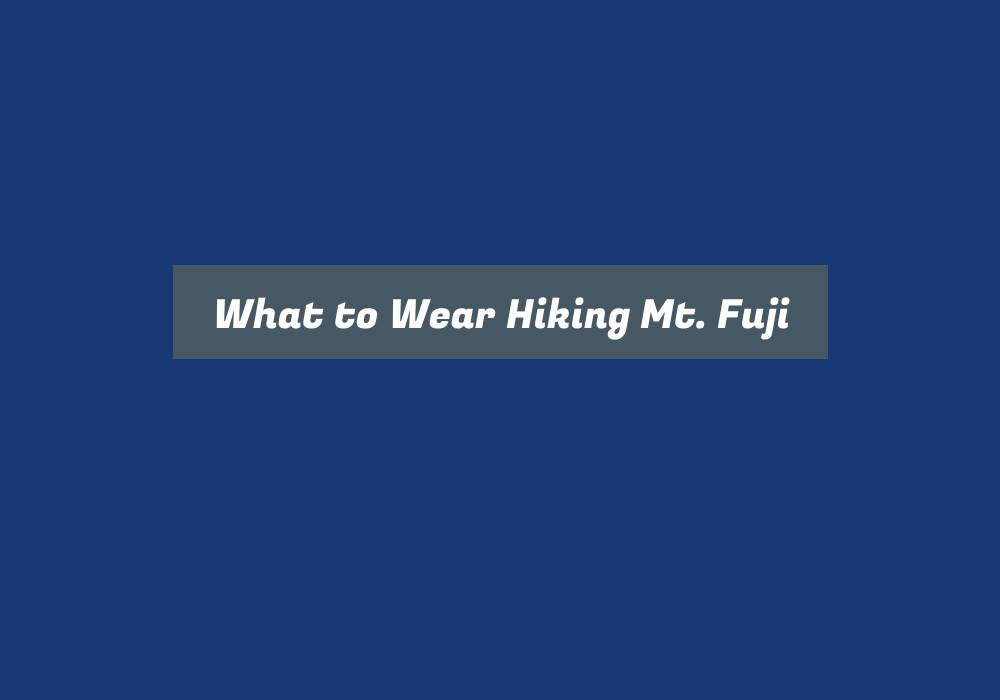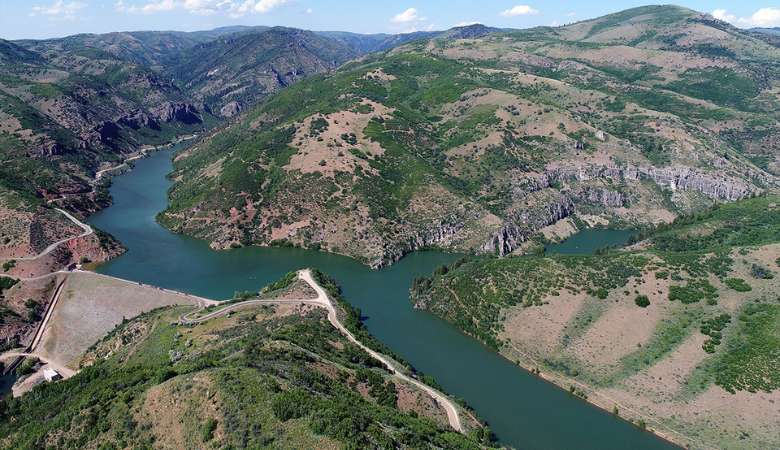Mount Fuji is Japan’s tallest and most iconic mountain, standing 12,388 feet (3,776 meters) tall. Hiking Mt. Fuji is a popular activity, with over 300,000 people summiting during peak season from July to September. However, Mt. Fuji has unpredictable weather and temperatures that vary greatly with altitude. Choosing the proper clothing and gear for hiking Mt. Fuji is essential to stay comfortable and safe during your ascent. This article provides a detailed packing list and recommendations for what to wear when climbing Mount Fuji.
Mt. Fuji Weather and Climate
Mt. Fuji has distinct climate zones that change as you gain elevation. Conditions also vary dramatically by season. Use this overview to guide your outfit planning:
- Base (4,500-7,500 ft / 1,400-2,300 m) – Warm and humid in summer. Light jackets are needed for cool nights and mornings.
- Sub-Alpine (7,500-9,500 ft / 2,300-3,000 m) – Much cooler with frequent rain and winds. Temps average 40-50°F.
- Alpine (9,500+ ft / 3,000+ m) – Zone near the summit. Frigid temps around freezing with snow possible any season. High winds.
Mt. Fuji has a short hiking season due to extreme winter conditions. Most climb during the official season:
- July to mid-September – Warmest and driest period. Daytime highs are are 50-70°F.
- Late June and October – Colder temperatures. Snow is more likely on the summit. Short days.
Always check current forecasts before your hike and pack accordingly. The weather changes rapidly on Mt. Fuji.
Layering System
The best way to dress for Mt. Fuji is by using a layering system. This lets you adjust your clothing layers based on the climate zone, activity level, and weather conditions:
Base Layer
Worn next to the skin. Lightweight and moisture-wicking to keep you dry.
- Synthetic t-shirt
- Long underwear tops and bottoms
Insulation Layer
Mid layer for warmth. Fleece or down work well.
- Fleece jacket
- Down or synthetic insulated vest
Outer Shell
Protects from rain, wind, and cold. Focus on waterproofing.
- Waterproof-breathable rain jacket
- Waterproof pants
Additional Tips
- Avoid cotton which absorbs moisture and chills you
- Bring extra base layers for change when wet
- Layer up before you get cold and down before overheating
- Have insulation options for variable temperatures
Recommended Clothing by Season
Packing the proper clothing varies based on when you’ll climb Mt. Fuji. Follow these general recommendations by season:
Summer (July – September)
Mt. Fuji’s warmest yet most crowded hiking season. Prepare for heat at lower elevations and wind/cold up high:
- Base layers – Lightweight synthetic or merino wool
- Mid layers – Fleece jacket, vest
- Shell jacket – Windproof with light insulation
- Pants – Hiking pants or shorts with base layer tights
- Accessories – Warm hat, gloves, buff/gaiter
Spring & Fall (May, June, October)
Cooler temperatures are likely. Snow more common at the summit:
- Base layers – Silk or merino long underwear
- Mid layers – Fleece jacket, heavyweight down insulated jacket
- Shell jacket – Waterproof and insulated
- Pants – Waterproof shell pants over long underwear
- Accessories – Warm winter hat, thick gloves, balaclava
Winter (November to April)
Mt. Fuji’s off-season with heavy snow and ice. Summit is closed:
- All insulating mid layers – Fleece, down
- 3-in-1 waterproof insulated shell jacket
- Insulated bib snow pants
- Heavy snow boots
- Thick snow gloves with liner
- Neck gaiter, ski goggles, winter boots
Recommended Gear and Accessories
Having proper hiking gear and accessories makes summiting Mt. Fuji much safer and enjoyable:
Footwear
- Lightweight hiking boots or trail runners
- Trekking poles for traction and stability
- Gaiters (spring and fall to keep snow out of boots)
Pack
- 25-40 liter daypack with waist and chest straps
- Waterproof pack cover or liner
Headwear
- Warm fleece hat
- Balaclava or neck gaiter
- Baseball cap or sun hat
- Sunglasses
Lighting
- Headlamp with extra batteries (for a pre-dawn start)
- Flashlight or lantern for hut
Other Accessories
- High SPF sunscreen
- Insulated gloves or mittens
- Lightweight synthetic or fleece gloves
- Buff or neck gaiter
- Insect repellent
- Light first aid kit
- Pocket knife or multi-tool
- Map and compass
- Toilet paper
- Whistle
- Sleeping mask and ear plugs (for huts)
Equipment Packing Checklist
Use this packing checklist when preparing for your Mt. Fuji hike:
| Category | Item | Quantity |
|---|---|---|
| Clothing – Base Layers | Synthetic or merino T-shirts | 2 |
| Long underwear tops | 2 | |
| Long underwear bottoms | 1 | |
| Underwear | 3 | |
| Athletic bras | 2 | |
| Hiking socks | 3-4 | |
| Clothing – Insulation | Fleece jacket | 1 |
| Insulated vest (optional) | 1 | |
| Warm hat | 1 | |
| Mittens or gloves | 2 | |
| Clothing – Outerwear | Waterproof jacket | 1 |
| Waterproof pants | 1 | |
| Lightweight gloves | 1 | |
| Footwear | Hiking boots/shoes | 1 |
| Camp shoes (optional) | 1 | |
| Gear | Backpack (25-40L) | 1 |
| Trekking poles | 1 | |
| Headlamp | 1 | |
| Sunglasses | 1 | |
| Buff/neck gaiter | 1 | |
| Sun hat | 1 | |
| Personal Items | Toiletries | 1 |
| Medications | 1 | |
| Towel | 1 | |
| Watch | 1 | |
| Wallet & ID | 1 | |
| Cell phone & charger | 1 | |
| Sleeping mask & earplugs | 1 | |
| Safety & Navigation | Maps | 1 |
| Compass | 1 | |
| Whistle | 1 | |
| First aid kit | 1 | |
| Flashlight/lantern | 1 |
Adjust quantities and gear based on your needs. But this covers the hiking essentials for Mt. Fuji.
When to Start Summit Hike
Most hikers start around 10 pm-2 am to summit Mt. Fuji for sunrise. The climb takes 5-8 hours roundtrip. Time your summit bid based on:
- fitness level and pace
- crowds and congestion on the trail
- hut stays or camping overnight
Tips:
- Start earlier (10pm-midnight) to avoid shoulder-to-shoulder crowds
- Allow 8+ hours if new to hiking or not aerobically fit
- Schedule extra time for stops, photos, fatigue, and delays
- Bring a headlamp, warm layers, and snacks to start hiking at night
Safety Tips
- Check the weather forecast and radar before your hike
- Climb only when the weather is dry and stable
- Turn back if conditions deteriorate or you feel unwell
- Stay on marked trails, no shortcuts
- Watch footing on steep, loose volcanic rock
- Altitude sickness is a risk above 8,000 ft (2,400 m)
- Stay hydrated and refuel with high-energy snacks
- Pack essential safety gear like a headlamp, map, and extra clothing
- Acclimatize by hiking shorter mountains first (optional)
- Allow plenty of days after your hike for recovery
Conclusion
Hiking Mt. Fuji requires proper preparation and packing for the extreme altitude and rapidly changing conditions. Use the layering system, recommended clothing lists, and gear checklist in this article to outfit yourself for Mt. Fuji’s challenging environment. Focus on lightweight, weatherproof, insulating clothing, and bring proper accessories for safety and comfort. Stay tuned into weather forecasts leading up to your hike. By planning ahead and packing strategically, you’ll be ready to take on Japan’s iconic peak and have an amazing experience climbing Mount Fuji!
Frequently Asked Questions About Hiking Mt. Fuji (FAQ)
What is the best time of year to climb Mt. Fuji?
July to early September is the official hiking season with the mildest weather and the least chance of snow. However, trails are most crowded then. Late June and October offer fewer crowds but colder temps.
What should I wear to climb Mt. Fuji in summer?
In summer, wear light synthetic base layers, fleece mid layers, and a waterproof-breathable outer shell. Bring a warm hat, gloves, and a windproof jacket for the cold summit.
What gear do I need to climb Mt. Fuji?
Essential gear includes hiking shoes, trekking poles, a 25-40L backpack, waterproof layers, a warm hat and gloves, a headlamp, a map, a first aid kit, and plenty of warm clothing.
How many base layers should I wear?
Start with one lightweight synthetic or merino wool base layer on the bottom and top. Pack extras to change into if your layers get wet from rain or sweat.
Should I wear shorts or pants to hike Mt. Fuji?
Wear hiking pants since the temperatures are cool for most of the climb. Shorts can work for the bottom portion on hot summer days.
Are waterproof hiking boots necessary?
Waterproof boots are ideal but trail runners can work in dry weather. The key is grippy traction and ankle support on steep volcanic terrain.
How many jackets and layers should I bring?
Pack at least three insulation layers including base, midweight fleece, and a puffy down or synthetic jacket. Plus a waterproof outer shell.
What’s the best way to layer clothes for Mt. Fuji?
Use a layering system – lightweight wicking base layer, midweight insulating fleece, and waterproof-breathable outer shell to shed wind and rain.
Can I rent cold weather gear on Mt. Fuji?
No, it’s best to bring your own. Some huts rent basic items but selection is limited. Don’t count on finding gear to rent.
Is a 0°F/-18°C sleeping bag warm enough to camp on Mt. Fuji?
Yes, that rating is warm enough for summer. Just supplement with insulating pads and layers. Go lower for spring/fall like -15°F/-26°C.
Do I need hiking gaiters?
Gaiters are recommended in spring and fall to keep snow and rain out of your boots and shoes when the weather is wetter.
How steep is the hiking trail up Mt. Fuji?
The trail up Mt. Fuji ascends 4,600 feet (1,400 m) over just 6 miles. It is a constant steep grade with loose gravel and volcanic rock.
Should I hike Mt. Fuji solo or with a guide?
If inexperienced, go with a guide for safety and navigation. Solo is fine for experienced mountaineers familiar with the risks and mountains.
How expensive is it to climb Mt. Fuji?
It’s quite affordable. The trial fee is just $10 USD. Gear, food, and hut stays will be your main costs if not camping.
Do cell phones work on the Mt. Fuji hiking trail?
Cell coverage is usually available but sporadic on parts of the trail. Carry paper maps as backup and limit reliance on phones.
How cold does it get at the summit of Mt. Fuji?
Temperatures at the summit typically range from 30-50°F (-1 to 10°C) but can feel much colder with strong winds. Dress very warmly.
Is altitude sickness a risk when hiking Mt. Fuji?
Yes, altitude sickness is not uncommon above 8,000 feet. Watch for symptoms like headache, nausea, fatigue, and shortness of breath. Descend if developing.
Should I hike Mt. Fuji at night or day?
Most climb overnight to the summit for sunrise. The trail is very crowded during the day. Trekking at night is safer with proper gear like a headlamp.
How many days should I take to climb Mt. Fuji?
1-2 days is standard. Climb overnight, watch the sunrise from the summit, descend the same day, or stay in a hut and descend the next morning.
Can you hike down Mount Fuji on the same day?
Yes, you can hike up and down in one day but it’s a very long, tiring day. Consider staying in a hut to rest then descend the next morning.
You May Also Like

My name is David James I am an adventurous hiker based in California. Through this weblog, I percentage my passion for exploring nature’s wonders, documenting breathtaking trails and hidden gemstones.



